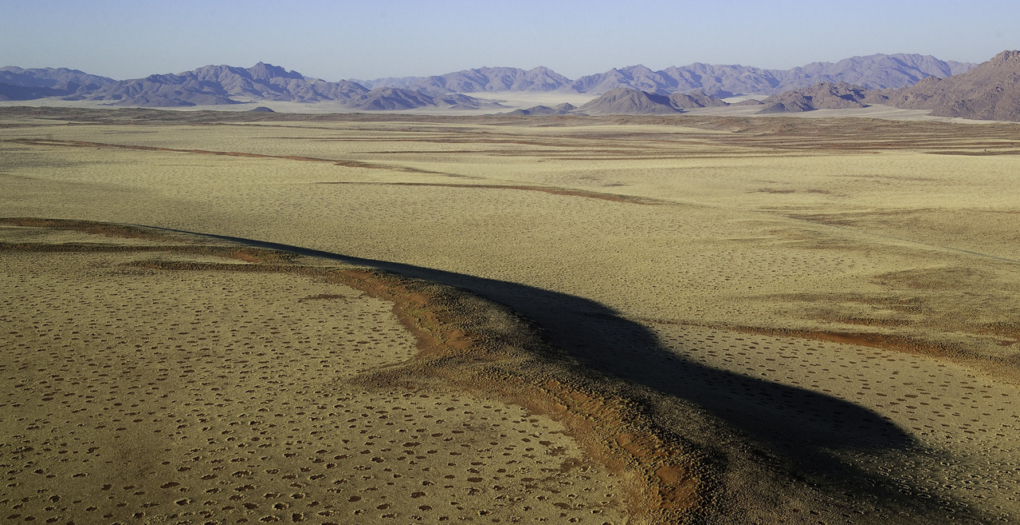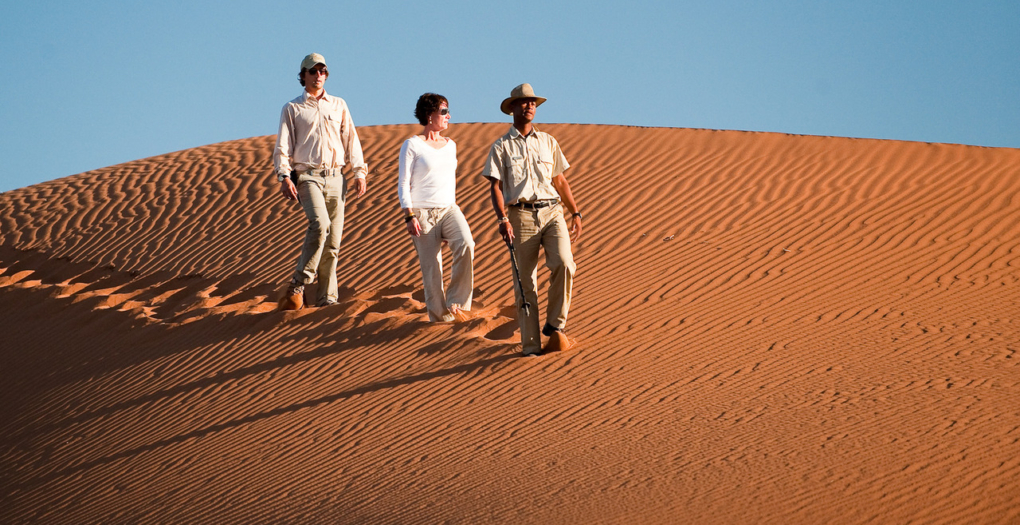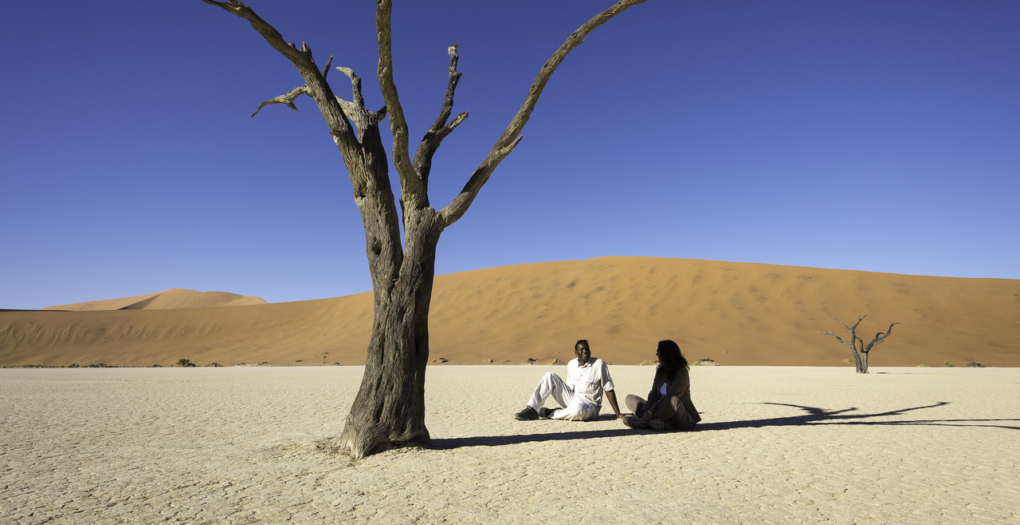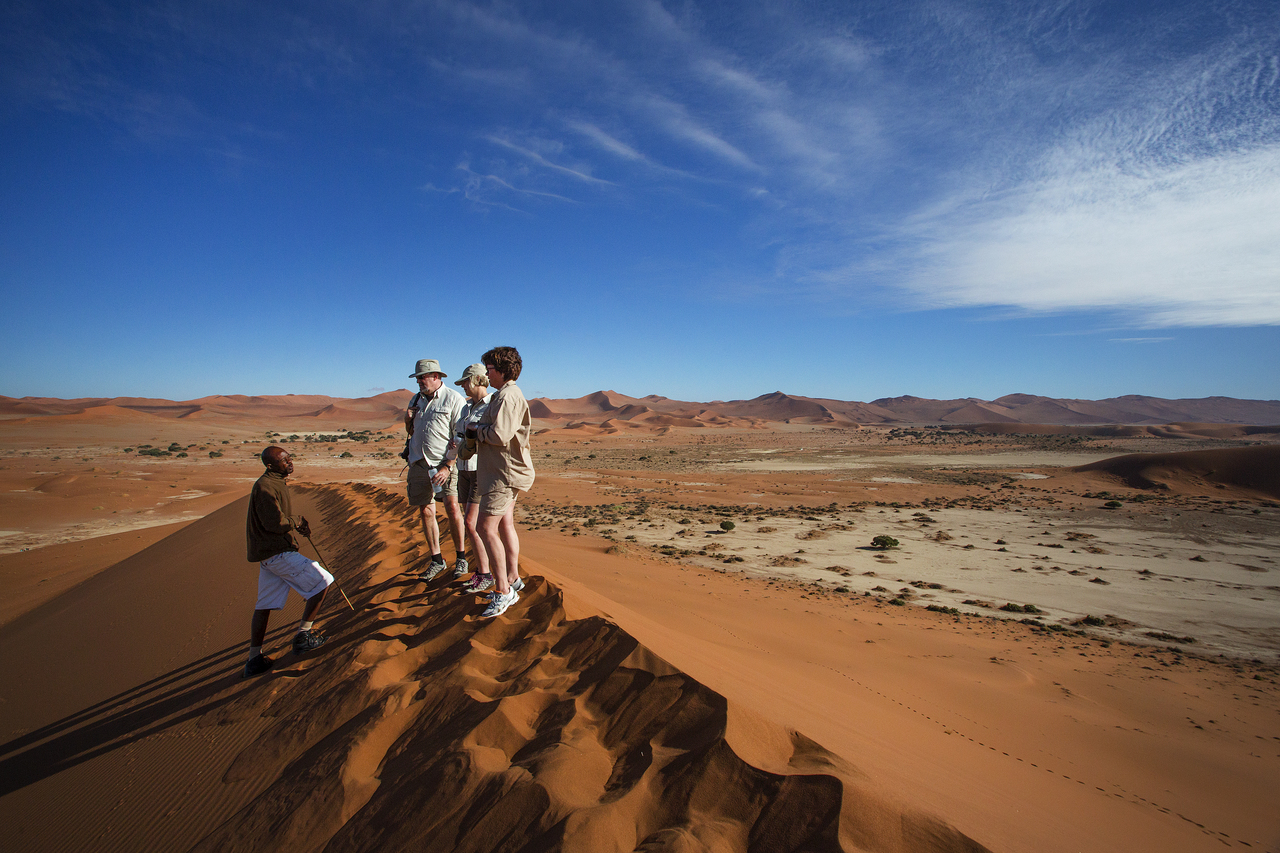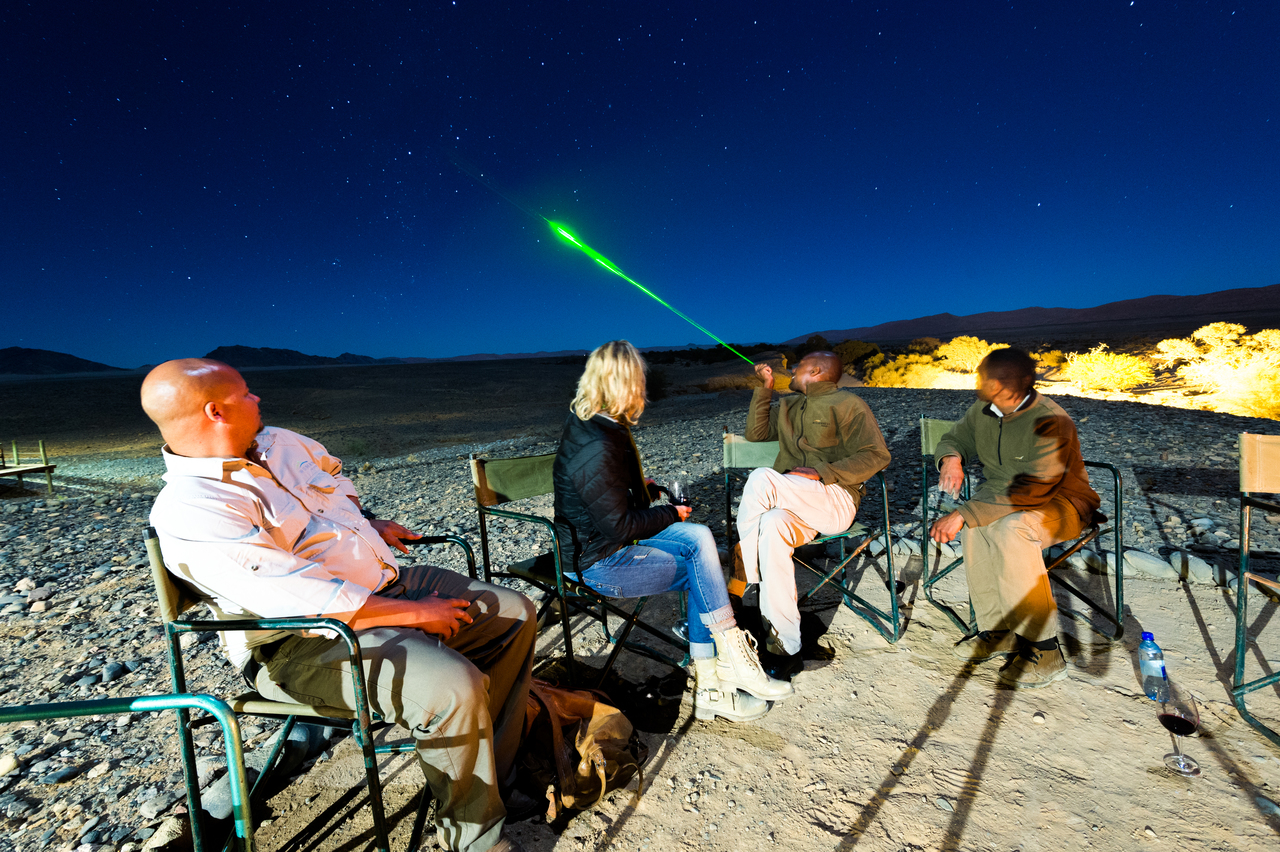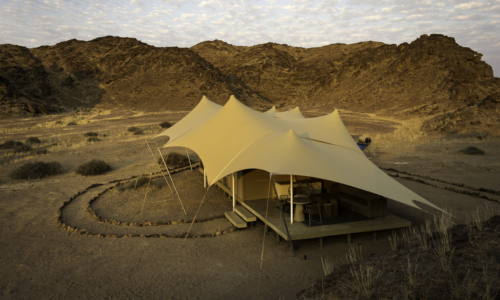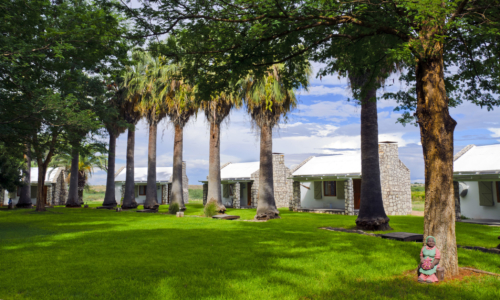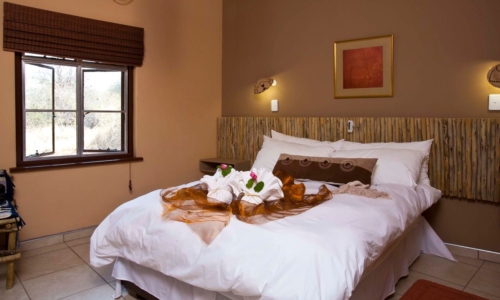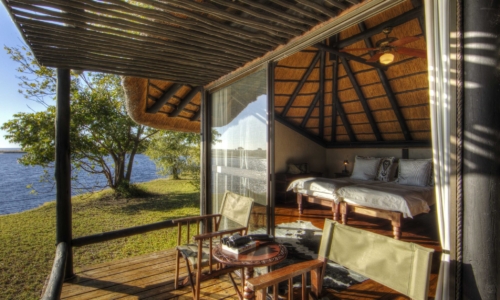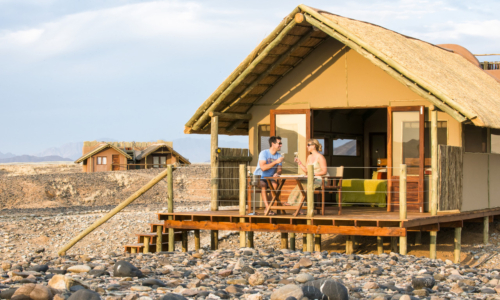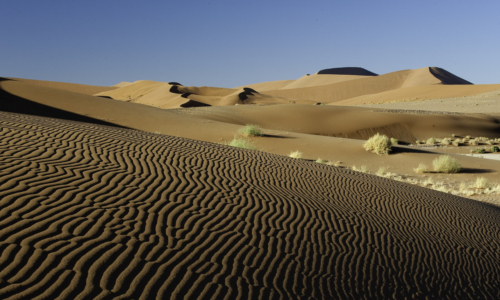Located in the largest conservation area in Africa, the Namib-Naukluft National Park, the dunes range in color from deep orange to bright pink. Moreover, the dunes are some of the largest in the world, occasionally exceeding 1,000 feet. The fascinating colors of the dunes are due to oxidation of the sand’s high iron content. The older dunes are more intensely red, and some of the more stable dunes are partially covered with vegetation. Underground and ephemeral rivers occasionally flood the pans, creating marshes known as vlei in the Afrikaans language. The other key source of water for Sossusvlei is the dense ocean fogs created when the dry desert air forces the humid ocean air downward.
The region has a number of plants and animals adapted for this unique climate, ranging from lizards to rodents to jackals to ostriches. With temperatures reaching up to 104 degrees Fahrenheit during the heat of the day only to plummet to below freezing at night, it is surprising how many animals have evolved to these harsh desert conditions. Beneath the red sands live many kinds of spiders, beetles, snakes, and geckos. In fact, the Namib desert beetle has adapted to extract water from the morning fogs via the bumps on its back.
Some of the larger mammals in such as the ostrich, springbok, gemsbok, and hyena thrive in their dry home. While some smaller mammals come out during the cool of the night including bat-eared fox, black-backed jackal, porcupine, Cape fox and aardwolf. During the rare flood season when the Tsauchab River forms a glassy lake, migrant bird species make temporary homes in the marshes. A photographer’s dream come true, the red dunes stand in contrast to a sea of pink as flamingos flock to the rare waters in the pan.
There are many activities available for enjoying and photographing the rare beauties of the desert. Most nearby safari lodges offered daily and nightly guided game drives. For the more adventurous, quad bike tours take on the heights of the dunes. Nature walks are a great way to explore the smaller flora and fauna of the region including the rare Welwitschia plant. These fascinating plants are thousands of years old and survive by extracting the moisture in the air. A photographic safari is ideal for anyone wanting to capture the stunning rock formations of Sesriem Canyon or the skeletal remains of black camel trees punctuating the white pan floor and ringed by the rust-red dunes of the Dead Vlei. A hot air balloon ride provides the perfect aerial view over this uniquely colored and textured landscape.

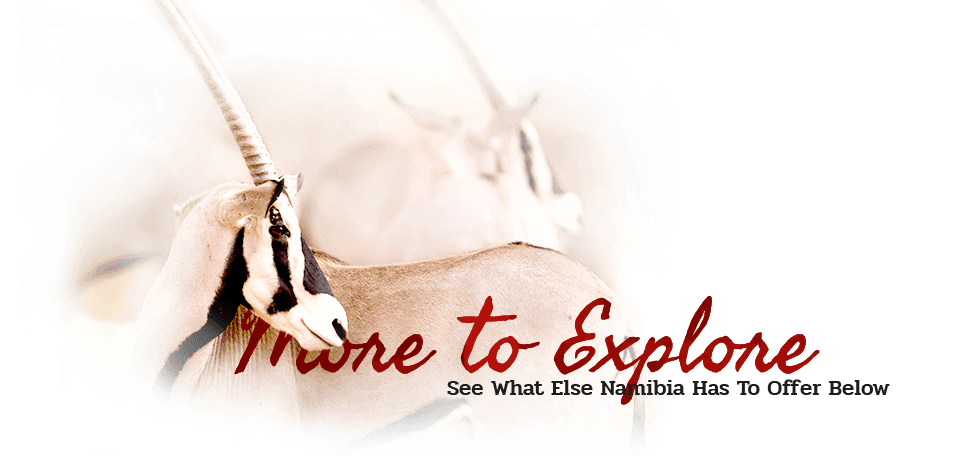
- Anderssons at Ongava
- Babson House
- Camp Kipwe
- Canyon Lodge
- Canyon Roadhouse
- Canyon Village
- Cape Cross Lodge
- Chobe Savanna Lodge
- Damara Mopane Lodge
- Damaraland Camp
- Dead Valley Lodge
- Desert Hills Glamping Camp
- Desert Homestead
- Desert Homestead Outpost
- Desert Rhino Camp
- Dolomite Camp
- Doro Nawas Camp
- Eagle’s Nest Lodge
- Erongo Wilderness Lodge
- Etosha Heights Safari House
- Etosha Mountain Lodge
- Etosha Safari Camp
- Etosha Safari Lodge
- Fish River Lodge
- Fort Sesfontein Lodge
- Grootberg Lodge
- Halali Camp
- Hoanib Elephant Camp
- Hoanib Skeleton Coast Camp
- Hoanib Valley Camp
- Ichingo Chobe River Lodge
- Kalahari Anib Lodge
- Kalahari Farmhouse
- Khorixas Rest Camp
- Kulala Desert Lodge
- Kwessi Dunes
- Little Kulala
- Little Ongava
- Malansrus Tented Camp
- Mowani Mountain Camp
- Mushara Bush Camp
- Mushara Lodge
- Mushara Outpost
- Naankuse Lodge
- Namib Desert Lodge
- Namushasha River Lodge
- Namutoni Camp
- Nhoma Safari Camp
- Nkasa Linyanti
- Okahirongo Elephant Lodge
- Okahirongo River Camp
- Okaukuejo Camp
- Okonjima Bush Camp
- Okonjima Bush Suite
- Okonjima Grand African Villa
- Okonjima Plains Camp
- Onduli Ridge
- Ongava Lodge
- Ongava Tented Camp
- Onguma Bush Camp
- Onguma Etosha Aoba Lodge
- Onguma Tented Camp
- Onguma The Fort
- Onguma Tree Top Camp
- Onkoshi Camp
- Ozondjou Trails
- Popa Falls Camp
- River Crossing Lodge
- Safarihoek Lodge
- Serra Cafema Camp
- Shipwreck Lodge
- Sossus Dune Lodge
- Sossusvlei Desert Lodge
- Terrace Bay Camp
- Teufelskrallen Tented Lodge
- Villa Mushara
- Wolwedans Boulders Camp
- Wolwedans Desert Lodge
- Wolwedans Dune Camp
- Wolwedans Mountain View Suite
- Wolwedans Plains Camp
- Anderssons at Ongava
- Babson House
- Camp Kipwe
- Canyon Lodge
- Canyon Roadhouse
- Canyon Village
- Cape Cross Lodge
- Chobe Savanna Lodge
- Damara Mopane Lodge
- Damaraland Camp
- Dead Valley Lodge
- Desert Hills Glamping Camp
- Desert Homestead
- Desert Homestead Outpost
- Desert Rhino Camp
- Dolomite Camp
- Doro Nawas Camp
- Eagle’s Nest Lodge
- Erongo Wilderness Lodge
- Etosha Heights Safari House
- Etosha Mountain Lodge
- Etosha Safari Camp
- Etosha Safari Lodge
- Fish River Lodge
- Fort Sesfontein Lodge
- Grootberg Lodge
- Halali Camp
- Hoanib Elephant Camp
- Hoanib Skeleton Coast Camp
- Hoanib Valley Camp
- Ichingo Chobe River Lodge
- Kalahari Anib Lodge
- Kalahari Farmhouse
- Khorixas Rest Camp
- Kulala Desert Lodge
- Kwessi Dunes
- Little Kulala
- Little Ongava
- Malansrus Tented Camp
- Mowani Mountain Camp
- Mushara Bush Camp
- Mushara Lodge
- Mushara Outpost
- Naankuse Lodge
- Namib Desert Lodge
- Namushasha River Lodge
- Namutoni Camp
- Nhoma Safari Camp
- Nkasa Linyanti
- Okahirongo Elephant Lodge
- Okahirongo River Camp
- Okaukuejo Camp
- Okonjima Bush Camp
- Okonjima Bush Suite
- Okonjima Grand African Villa
- Okonjima Plains Camp
- Onduli Ridge
- Ongava Lodge
- Ongava Tented Camp
- Onguma Bush Camp
- Onguma Etosha Aoba Lodge
- Onguma Tented Camp
- Onguma The Fort
- Onguma Tree Top Camp
- Onkoshi Camp
- Ozondjou Trails
- Popa Falls Camp
- River Crossing Lodge
- Safarihoek Lodge
- Serra Cafema Camp
- Shipwreck Lodge
- Sossus Dune Lodge
- Sossusvlei Desert Lodge
- Terrace Bay Camp
- Teufelskrallen Tented Lodge
- Villa Mushara
- Wolwedans Boulders Camp
- Wolwedans Desert Lodge
- Wolwedans Dune Camp
- Wolwedans Mountain View Suite
- Wolwedans Plains Camp

Located in the largest conservation area in Africa, the Namib-Naukluft National Park, the dunes range in color from deep orange to bright pink. Moreover, the dunes are some of the largest in the world, occasionally exceeding 1,000 feet. The fascinating colors of the dunes are due to oxidation of the sand’s high iron content. The older dunes are more intensely red, and some of the more stable dunes are partially covered with vegetation. Underground and ephemeral rivers occasionally flood the pans, creating marshes known as vlei in the Afrikaans language. The other key source of water for Sossusvlei is the dense ocean fogs created when the dry desert air forces the humid ocean air downward.
The region has a number of plants and animals adapted for this unique climate, ranging from lizards to rodents to jackals to ostriches. With temperatures reaching up to 104 degrees Fahrenheit during the heat of the day only to plummet to below freezing at night, it is surprising how many animals have evolved to these harsh desert conditions. Beneath the red sands live many kinds of spiders, beetles, snakes, and geckos. In fact, the Namib desert beetle has adapted to extract water from the morning fogs via the bumps on its back.
Some of the larger mammals in such as the ostrich, springbok, gemsbok, and hyena thrive in their dry home. While some smaller mammals come out during the cool of the night including bat-eared fox, black-backed jackal, porcupine, Cape fox and aardwolf. During the rare flood season when the Tsauchab River forms a glassy lake, migrant bird species make temporary homes in the marshes. A photographer’s dream come true, the red dunes stand in contrast to a sea of pink as flamingos flock to the rare waters in the pan.
There are many activities available for enjoying and photographing the rare beauties of the desert. Most nearby safari lodges offered daily and nightly guided game drives. For the more adventurous, quad bike tours take on the heights of the dunes. Nature walks are a great way to explore the smaller flora and fauna of the region including the rare Welwitschia plant. These fascinating plants are thousands of years old and survive by extracting the moisture in the air. A photographic safari is ideal for anyone wanting to capture the stunning rock formations of Sesriem Canyon or the skeletal remains of black camel trees punctuating the white pan floor and ringed by the rust-red dunes of the Dead Vlei. A hot air balloon ride provides the perfect aerial view over this uniquely colored and textured landscape.

- Anderssons at Ongava
- Babson House
- Camp Kipwe
- Canyon Lodge
- Canyon Roadhouse
- Canyon Village
- Cape Cross Lodge
- Chobe Savanna Lodge
- Damara Mopane Lodge
- Damaraland Camp
- Dead Valley Lodge
- Desert Hills Glamping Camp
- Desert Homestead
- Desert Homestead Outpost
- Desert Rhino Camp
- Dolomite Camp
- Doro Nawas Camp
- Eagle’s Nest Lodge
- Erongo Wilderness Lodge
- Etosha Heights Safari House
- Etosha Mountain Lodge
- Etosha Safari Camp
- Etosha Safari Lodge
- Fish River Lodge
- Fort Sesfontein Lodge
- Grootberg Lodge
- Halali Camp
- Hoanib Elephant Camp
- Hoanib Skeleton Coast Camp
- Hoanib Valley Camp
- Ichingo Chobe River Lodge
- Kalahari Anib Lodge
- Kalahari Farmhouse
- Khorixas Rest Camp
- Kulala Desert Lodge
- Kwessi Dunes
- Little Kulala
- Little Ongava
- Malansrus Tented Camp
- Mowani Mountain Camp
- Mushara Bush Camp
- Mushara Lodge
- Mushara Outpost
- Naankuse Lodge
- Namib Desert Lodge
- Namushasha River Lodge
- Namutoni Camp
- Nhoma Safari Camp
- Nkasa Linyanti
- Okahirongo Elephant Lodge
- Okahirongo River Camp
- Okaukuejo Camp
- Okonjima Bush Camp
- Okonjima Bush Suite
- Okonjima Grand African Villa
- Okonjima Plains Camp
- Onduli Ridge
- Ongava Lodge
- Ongava Tented Camp
- Onguma Bush Camp
- Onguma Etosha Aoba Lodge
- Onguma Tented Camp
- Onguma The Fort
- Onguma Tree Top Camp
- Onkoshi Camp
- Ozondjou Trails
- Popa Falls Camp
- River Crossing Lodge
- Safarihoek Lodge
- Serra Cafema Camp
- Shipwreck Lodge
- Sossus Dune Lodge
- Sossusvlei Desert Lodge
- Terrace Bay Camp
- Teufelskrallen Tented Lodge
- Villa Mushara
- Wolwedans Boulders Camp
- Wolwedans Desert Lodge
- Wolwedans Dune Camp
- Wolwedans Mountain View Suite
- Wolwedans Plains Camp
- Anderssons at Ongava
- Babson House
- Camp Kipwe
- Canyon Lodge
- Canyon Roadhouse
- Canyon Village
- Cape Cross Lodge
- Chobe Savanna Lodge
- Damara Mopane Lodge
- Damaraland Camp
- Dead Valley Lodge
- Desert Hills Glamping Camp
- Desert Homestead
- Desert Homestead Outpost
- Desert Rhino Camp
- Dolomite Camp
- Doro Nawas Camp
- Eagle’s Nest Lodge
- Erongo Wilderness Lodge
- Etosha Heights Safari House
- Etosha Mountain Lodge
- Etosha Safari Camp
- Etosha Safari Lodge
- Fish River Lodge
- Fort Sesfontein Lodge
- Grootberg Lodge
- Halali Camp
- Hoanib Elephant Camp
- Hoanib Skeleton Coast Camp
- Hoanib Valley Camp
- Ichingo Chobe River Lodge
- Kalahari Anib Lodge
- Kalahari Farmhouse
- Khorixas Rest Camp
- Kulala Desert Lodge
- Kwessi Dunes
- Little Kulala
- Little Ongava
- Malansrus Tented Camp
- Mowani Mountain Camp
- Mushara Bush Camp
- Mushara Lodge
- Mushara Outpost
- Naankuse Lodge
- Namib Desert Lodge
- Namushasha River Lodge
- Namutoni Camp
- Nhoma Safari Camp
- Nkasa Linyanti
- Okahirongo Elephant Lodge
- Okahirongo River Camp
- Okaukuejo Camp
- Okonjima Bush Camp
- Okonjima Bush Suite
- Okonjima Grand African Villa
- Okonjima Plains Camp
- Onduli Ridge
- Ongava Lodge
- Ongava Tented Camp
- Onguma Bush Camp
- Onguma Etosha Aoba Lodge
- Onguma Tented Camp
- Onguma The Fort
- Onguma Tree Top Camp
- Onkoshi Camp
- Ozondjou Trails
- Popa Falls Camp
- River Crossing Lodge
- Safarihoek Lodge
- Serra Cafema Camp
- Shipwreck Lodge
- Sossus Dune Lodge
- Sossusvlei Desert Lodge
- Terrace Bay Camp
- Teufelskrallen Tented Lodge
- Villa Mushara
- Wolwedans Boulders Camp
- Wolwedans Desert Lodge
- Wolwedans Dune Camp
- Wolwedans Mountain View Suite
- Wolwedans Plains Camp










